Click Draft Analysis
 in the Shape Analysis toolbar. in the Shape Analysis toolbar.
The Draft Analysis dialog box is displayed.

Set up your analysis: - In the Mode area of the dialog box, select Quick Analysis Mode
 . .
- In the Display area of the dialog box, select Show/Hide color scale
 . . The Draft Analysis.x dialog box is displayed. It shows the color
scale and identifies the corresponding values for the
analysis.
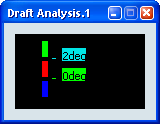
Select a surface for analysis. The quick analysis is displayed on the surface. The draft direction is the w/z axis of the compass.
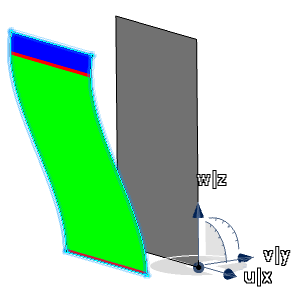
In the Mode area of the dialog box, select Full Analysis Mode  . . The color scale and range of values in the Draft Analysis.x dialog box are expanded. The corresponding colors are displayed on the surface.
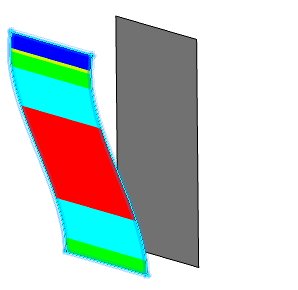
Optional: Modify the colors and/or values in the color scale (right-click a color or value). In the Display area of the dialog box, select On the Fly and move the pointer over the surface. and move the pointer over the surface. The following information about the current pointer location is displayed:
- Green arrow, N: The normal to the surface
- Red arrow, D: The draft direction
- Blue arrow, T: The tangent to the surface
- Circles: The plane tangent to the surface
- Value (reverse highlighted): The angle between the draft
direction and the tangent to the surface (the value is expressed in the units set in Tools > Options
> General > Parameters > Units tab)
- The cone
- Value (unhighlighted): The cone angle (the angle between the axis of the cone and the draft direction D)
As you move the pointer over the surface, this information is updated dynamically.

Note that you can activate the On the fly option
even when not visualizing the materials. It gives you the tangent
plane and the deviation value. Click Inverse
 to reverse the draft direction.
to reverse the draft direction.
This command affects all selected elements.
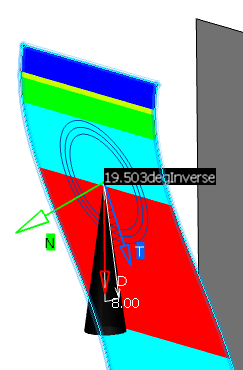
Right-click the cone angle to display the Angle
Tuner dialog box and then modify the angle using the up/down arrows.

The value is automatically updated in the color scale dialog box, on
the geometry and the cone diameter is adjusted. The value in the color scale dialog box (16.961deg in the example shown below) is highlighted in a different color .

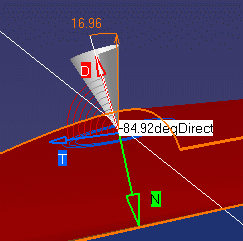
Right-click the red arrow, D (draft direction) to display a contextual
menu. From the contextual menu you can:
- Hide/show the cone.
- Hide/show the angle.
- Hide/show the tangent.
- Lock/unlock the analysis position.
- Keep the point at this location (a Point.xxx appears in the specification tree).
Define a new draft direction and then lock the direction: - In the Draft Analysis dialog box, click Compass
 . . The compass is placed in the 3D area.
- As required, drag and rotate the compass until the w/z axis is aligned with the required new draft direction.
The D draft direction arrow changes direction accordingly.
- In the Draft Analysis dialog box, click Lock draft direction
 . . The draft direction (D, red arrow) is locked in the new direction. If you make subsequent adjustments to the compass, the draft direction will remain unchanged.
When you have finished working with this command, do one of the following: - To create the analysis, click OK.
The analysis is added to the specification tree where it is identified as Command_Name.Analysis.x. The analysis will be updated automatically whenever you modify any of the elements in the analysis (for example when you deform an element using control points).
- To abandon the analysis, click Cancel.
Note:
- Note that settings are saved when exiting the command,
and redisplayed when you select Draft Analysis
 again. again.
- Be careful, when selecting the direction, not to deselect
the analyzed element.
- A draft analysis can be performed just as well on a
set of surfaces.
- If an element belongs to an analysis, it cannot be selected
simultaneously for another analysis; you need to remove
the current analysis by deselecting the element to be able
to use it again.
- In some cases, even though the rendering style is properly
set, it may happen that the analysis results are not visible.
Check that the geometry is up-to-date, or perform an update
on the involved geometric elements.
- The analysis results depend of the current object. May
you want to change the scope of analysis, use the Define
in Work object contextual command.
|
 again.
again.







